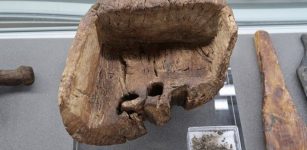Has The Mystery Of The Lost Trading Ship Zuytdorp Been Solved?
Conny Waters - AncientPages.com - Archaeologists have been investigating the enigma of the Zuytdorp, an 18th-century trading vessel from the Dutch East India Company. Dispatched on August 1, 1711, from the Netherlands to Batavia (modern-day Jakarta, Indonesia), the Zuytdorp was laden with newly minted silver coins.
Background: Shipwreck by Claude Joseph Vernet (1714–1789). Public Domain - Left corner: VOC chart - Credit: NA 4.VELH-150. Image compilation: AncientPages.com
Many trading ships of that era navigated via the Brouwer Route, harnessing the powerful Roaring Forties winds to traverse the Indian Ocean towards Australia's west coast—then known as New Holland—before turning north to Batavia.
However, the Zuytdorp never reached its intended destination and vanished without a trace. In a renewed effort to unravel this mystery, researchers have examined ship logs alongside contemporary cartographic and navigational insights and weather conditions of that period.
A recent study by Flinders University archaeologists Dr. Ruud Stelten and Professor Wendy van Duivenvoorde proposes that rather than poor navigation being at fault, it was likely a storm that caused the Zuytdorp to crash into Western Australia's shoreline in 1712.
Over the past century, four Dutch shipwrecks have been discovered off the coast of Western Australia. Among these, the Batavia is perhaps the most renowned, largely due to the notorious events involving its mutinous crew. Another significant find is the Zuytdorp, which was located in 1927 approximately 60 kilometers north of Kalbarri, a coastal town in WA. It wasn't until 1958 that this ship was formally identified. The Zuytdorp had embarked from Vlissingen in the Netherlands and was en route to Batavia—modern-day Jakarta—when it tragically disappeared at sea.
The Zuytdorp’s wreck site (red oval) at the base of the cliffs. Credit: Western Australian Museum
"Since the wreck of the Zuytdorp was identified, many theories exist as to how the ship crashed, including poor navigation or misadventure, but despite being the subject of a number of archaeological investigations, the exact circumstances of the ship's demise have remained unclear," says Dr. Stelten from Flinders' College of Humanities, Arts and Social Sciences.
Similar to other shipwrecks off the coast of Western Australia, a prominent theory regarding the ship's crash involves challenges in determining longitude. Without precise knowledge of their eastward position, the crew could not accurately gauge their distance from Australia's western coastline, leading to unexpected encounters with land.
The authors conducted an analysis of contemporary cartographic and navigational knowledge by examining the charts accessible to the ship's officers, assessing coastal visibility, and reviewing signs indicating proximity to land as documented in contemporary ship logs.
"Our analysis suggests the Zuytdorp's officers had access to sufficient cartographic information to navigate the Indian Ocean and the Western Australian coastline effectively," says Professor van Duivenvoorde, a leading maritime archaeologist in Flinders' College of Humanities, Arts and Social Sciences.
"The crew noted numerous warning signs that the vessel was nearing the coast and took various measures to avoid a collision, so the theory that they had a sudden and unexpected encounter with the shore is an unlikely scenario."
A manuscript VOC chart of the Indian Ocean dating to 1743. The western coast of Australia is depicted on the bottom right. Credit: NA 4.VELH-150
However, the authors were able to note the evidence of severe weather patterns in the region during the period in question.
"This is a key element to the unraveling of the mystery and shows the more likely scenario is that the ship reached the Australian coastline intentionally and was driven ashore by a storm," says Professor van Duivenvoorde.
The authors say the current research provides, for the first time, a detailed analysis of why one scenario is more likely to have occurred than the other.
"By examining historical records, navigational charts, and weather conditions, we have been able to piece together a more accurate picture of what likely happened to the Zuytdorp all those years ago," says Dr. Stelten.
"This study highlights the resilience and navigational skills of the VOC officers. The Zuytdorp's wrecking was not due to a lack of skill or information but rather the unpredictable nature of the sea."
According to the authors, the findings may indicate where the ship's lost anchors are located. Additionally, this approach could serve as an effective method for investigating and understanding what occurred with other shipwrecks globally.
The study was published in the Journal of Maritime Archaeology
Written by Conny Waters - AncientPages.com Staff Writer























